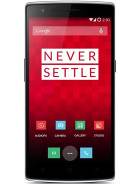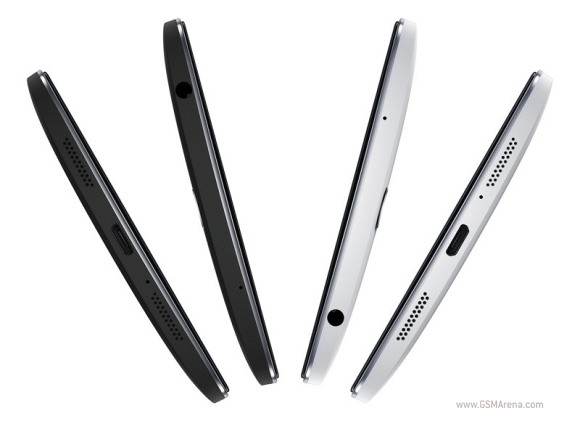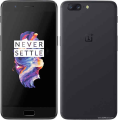OnePlus One Prices
Important Note.
- All prices are in Pakistani Rupee (PKR)
- Prices may vary at stores and our effort will be to provide you with the updated prices.
- The latest price of OnePlus One was obtained on 17 مئی, 2019. The prices at the original stores had been updated on the respective mentioned dates.
- Find out WhatMobile price has dropped in Pakistan by selecting Notify Price Drop button
- Find out WhatMobile has better specifications by clicking Add To Compare Button find out what Mobile has better reviews by visiting our reviews section
- Find out WhatMobile is cheaper on which retailer by clicking Compare prices from retailers button
Search Terms
- OnePlus One
Specifications
| GENERAL | |
| 2G Network | GSM 850 / 900 / 1800 / 1900 |
|---|---|
| 3G Network | HSDPA 850 / 900 / 1700 / 1900 / 2100 |
| 4G Network | LTE band 1(2100), 3(1800), 4(1700/2100), 7(2600), 17(700), 38(2600), 40(2300) |
| Sim | Micro-SIM |
| Announced | 18/04/2014 |
| Status | Discontinued |
| BODY | |
| Dimensions | 152.9 x 75.9 x 8.9 mm (6.02 x 2.99 x 0.35 in) |
| Weight | 162 g (5.71 oz) |
| DISPLAY | |
| Display Size | 5.5 inches, 83.4 cm2 (~71.9% screen-to-body ratio) |
| Resolution | 1080 x 1920 pixels, 16:9 ratio (~401 ppi density) |
| MultiTouch | Yes, up to 10 fingers |
| Protection | Corning Gorilla Glass 3 - CyanogenMod 13 - Oxygen 2.1.4 |
| SOUND | |
| AlertTypes | Vibration; MP3, WAV ringtones |
| LoudSpeaker | Yes, dual mono speakers |
| 3.5mm jack | Yes - Active noise cancellation with dedicated mic |
| MEMORY | |
| CardSlot | No |
| Internal | 16 GB, 3 GB RAM |
| DATA | |
| GPRS | Yes |
| EDGE | Yes |
| Speed | HSPA 42.2/5.76 Mbps, LTE Cat4 150/50 Mbps |
| WLAN | Wi-Fi 802.11 a/b/g/n/ac, Wi-Fi Direct, DLNA, hotspot |
| Blue Tooth | 4.1, A2DP |
| NFC | Yes |
| USB | microUSB 2.0, USB Host |
| CAMERA | |
| Camera Primary | 13 MP (f/2.0, 1/3", 1.12 µm), autofocus, dual-LED flash |
| Camera Features | Geo-tagging, touch focus, face detection, panorama, HDR |
| CameraVideo | 2160p@30fps, 2160p(DCI)@24fps, 1080p@60fps, 720p@120fps, HDR, stereo sound rec |
| CameraSecondary | 5 MP, f/2.0, 1080p@30fps |
| FEATURES | |
| Processor Cores | Quad-Core |
| OS | Android 4.4.2 (KitKat), upgradable to 6.0.1 (Marshmallow) |
| CPU | Quad-core 2.5 GHz Krait 400 |
| Sensors | Accelerometer, gyro, proximity, compass |
| Messaging | SMS (threaded view), MMS, Email, IM, Push Email |
| Browser | HTML5 |
| Radio | No |
| GPS | Yes, with A-GPS, GLONASS |
| Colors | Silk White, Sandstone Black |
| Others | - ANT+ support - MP4/H.264/WMV player - MP3/eAAC+/WMA/WAV/FLAC player - Document viewer - Photo viewer/editor - Voice memo/dial/commands |
| BATTERY | |
| Battery | Non-removable Li-Po 3100 mAh battery |
| MISC | |
| SARUS | 0.62 W/kg (head) 0.75 W/kg (body) |
Reviews
Price: From £229 inc VAT
Rating: 9
OnePlus One review: What it is
The One from OnePlus is a high-end smartphone at a mid-range price. It's an Android smartphone running an OS based on 4.4.2 KitKat, with high-quality specifications, but in the UK it retails for form just £229. That's around a third of the price of the most expensive smartphones with which it shares key specifications. The catch? Well there really isn't much of one. See: OnePlus Two release date rumours: Something's happening on 22 July.
You can buy the One only from OnePlus, and online. And that's not all. You also need to get an invite to buy, either by asking someone who has bought a OnePlus phone for an invite - anyone who purchases a OnePlus One will receive invites to give out to friends and family - or by entering contests and promotional events hosted on the OnePlus Forums or social media channels. (And before you ask, we don't have any invites.)Read more about the possibility of aOnePlus One mini, aOnePlus One tablet, and aOnePlus Twophone.
You have to buy it SIM free, too, but that's always the cheapest way to buy a phone anyway. So the question is: is the OnePlus a bargain? Read on to find out. (See also: 34 best smartphones of 2014 UK.)
OnePlus One review: Build and design
Initial impressions are good. Very good. The OnePlus is well put together, and made of what feels like high-quality materials. A big, understated slab of black, look closer and you will find subtle curves. There's a chrome outer rim surrounding the large glass display, which is slightly raised beyond the rest of the handset.
The only major caveat is that the bezel at the top and bottom of the OnePlus One's display is bigger than we'd like. Put it next to the LG G3 - a phone with a similar-sized screen - and you'll see a big difference.
For the record the OnePlus One measures 153 x 76 x 8.9 mm and weighs in at 162 g. It's neither the thinnest nor the lightest big-screen smartphone on the market, but it feels good in the hand. Solid, but ergonomic.
The back of the handset is made of a material we can't place, with a finish we haven't seen before. It's rough like carpet, but soft to the touch. Like a material finish. That sounds bad, but it isn't. Everyone who picked up the OnePlus One in our office commented on and liked this.
The OnePlus One is available in black or white. We tried the black model, and we like it. It's different to other phones on the market, and in a good way.

OnePlus One review: Display
The whole phone is built around the display. It's a 5.5in IPS LCD capacitive touchscreen display boasting 16M colours. The resolution is impressive: not the best on the market, but plenty good enough at the best at this price. Spread over 5.5 inches, 1080 x 1920 pixels makes for a pixel density of 401 ppi. And how does it look? Sharp. Impressively so.
Watcing movies, viewing images, and browsing the web all look good. Colours are deep, resolution sharp. The only issue we had is that some colours look a little overblown. Whites on photos have a slightly yellowish tinge. It's good to look at, but doesn't feel particularly accurate.
Zoom in on text, however, and you will have to get very close before you are disappointed. Viewing angles are good, and the screen is lovely and bright.
The multitouch works well. It's rated for up to 10 fingers, but you'll have to take OnePlus's word for that. I'm in no way capable of using all 10 fingers at once on a laptop, let alone a phone. And we're impressed with the inclusion of Corning Gorilla Glass 3 in a 'cheap' phone. As indeed we are impressed with the display as a whole. It's a big thumbs up from me. (See also: Where is the OnePlus One phone? OnePlus One shipments delayed by customs.)
OnePlus One review: Specification
Here's the really good news: the spec is that of a £600 phone. You get a Qualcomm MSM8974AC Snapdragon 801, a quad-core Krait chip clocked at 2.5GHz. It's paired with 3GB RAM, and graphics are taken care of with a Adreno 330 GPU.
Connectivity specs include 4G LTE, 802.11 a/b/g/n/ac Wi-Fi, NFC and Bluetooth 4.0. But how does the One perform? (See also: OnePlus One release date, price, specs, pre-orders: Storm of Invites despite customs delay.)
OnePlus One review: Performance and benchmarks
You might expect that a less expensive smartphone would fall down on performance. But here again we are happy to say that things are good. In use the One feels zippy. Transitions are snappy, and even running multiple processes the OnePlus One keeps things moving. Even heavy-loading games run well on the OnePlus One. It's as good a performer as we've seen in the Android space. And that's praise indeed.
Benchmark scores bear this out. As ever, take synthetic benchmarks with a pinch of salt. They offer a guide to performance and nothing more. But in Geekbench 3 the OnePlus One managed average scores of single-core: 969 / multi-core: 2570. That puts it close but not quite up with the Samsung Galaxy S5. And that's more than okay.
Similarly in the GFXBench T-Rex onscreen test, an average score of 28.5fps (1,596) is very good if not top of the shop. And we got a very good result for javascript performance in the Sunspider benchmark: 877ms is excellent in this test.
Overall then performance is good. The OnePlus has the specification and the performance of a much more expensive flagship phone. Impressive stuff. (See also: The UK's 33 best Android smartphones of 2014.)

OnePlus One review: Storage
There are two storage options for the OnePlus One phone, and one big disappointment. The options are 16GB and 64GB - strangely no 32GB but it's becoming very rare to see 64GB on offer outside of the iPhone. And the disappointment? There is no storage expansion slot.
We tested the 64GB model, which came with 54.8GB free out of the box. And that's pretty good. But we do regret the lack of expandable storage. (See also: Inside the OnePlus One phone: What the specs don't tell you.)
OnePlus One review: Cameras
The OnePlus One has a 13 Mp Sony Exmor camera, with dual LED flash, and f/2.0 aperture. OnePlus tells us that the One camera has six physical lenses for greater detail, even at lower light conditions. It offers geo-tagging, touch focus, face detection, panorama and HDR, and captures video of up to 2160p (4K) at 30fps.
We haven't had time to test the camera as much as we'd like, but our early impressions are decent. The OnePlus can't match the superior cameras of the Galaxy S5 or the Xperia Z2, but it is perfectly adequate for a smartphone camera. You can take good photos with it. (See also: LG G3 vs OnePlus One comparison review: best smartphone and best value phone go head to head.)
Here are some OnePlus One camera test shots:
Click the shots to expand to full size.




Around the front is the 5 Mp selfie camera. This captures video at 1080p (Full HD) at 30fps for video calling. Overall the cameras are good if not top notch. Good enough, we'd say, considering the price of the phone.
OnePlus One review: Software
Here's where things get really interesting. The OnePlus One runs Android 4.4.2 KitKat, which is a sufficiently recent version to be great. But it is a customised version of Android. Indeed, it is different to Android, running an interface known as CyanogenMod. (OnePlus has now confirmed that within three months of Google releasing the final code for its forthcoming mobile OS the OnePlus One will also get Android L.)
Don't be frightened. You get access to Google Play. And when first you boot the OnePlus One you are asked if you want to run a custom OnePlus theme skin. If you opt not to go for this (we didn't) you get a very vanilla Android interface. It's all but a Nexus phone in that respect.
The interesting aspect is that you can install CyanogenMod themes that allow you to build your own skin for your smartphone. Choosing a specific theme allows you to tweak app icons and system fonts, your wallpaper, lock screen and so on. You can also specify changes to the way your smartphone works. But there is a caveat: the themes cost money, mostly. You won't break the bank buying them, but personally I'd rather live with vanilla Android.
OnePlus One review: Battery life
The OnePlus One comes with a large Li-Po 11.8Wh (3100 mAh) battery cell. And we have been impressed with battery life.
Out of the box the initial charge wasn't great, but it took a long time for the OnePlus to ship to me, so we won't hold that against the handset. Much more important is that with light use, 24 hours after charging, 67 percent of the battery life was left. That's a strong performance: we hadn't been doing much beyond email, messaging and social media, but that kills our iPhone 5 in 24 hours. Of course the battery will degrade as time goes buy.
Nonetheless, 48 hours after charging there is still 39 percent of battery life. And in the second 24 hours we made a point of streaming video clips, using Bluetooth and Wi-Fi, and running benchmarks to simulate heavier use. The OnePlus One charges quickly, too, so we'll forgive the US charger and adaptor with which it ships to the UK. It doesn't always want to charge via USB, even when we can get it to mount via the USB port and cable. Odd.
OnePlus tells us that the battery life is helped with an energy efficient display which adjusts the level of backlight and differentiates between dynamic and static content on the screen to reduce power consumption. We'll keep an eye on battery performace over time. But so far we are very impressed. (See also: Buy OnePlus One phone with or without an invite.)
Buying Advice
There are only two, possibly three, bad things to say about the OnePlus One, if you are happy to buy online direct from OnePlus. We wish there was expandable storage, and it's bigger than other smartphones with similarly sized displays. And if we are being really harsh, we would hope for a better camera. But at the price the OnePlus One is an amazing deal. It's a flagship smartphone for a mid-range price. Bargain. Get them while they are hot.Write Your Own Review
My Recent Reviews
- Be first to post review for this product.
comments powered by Disqus




























